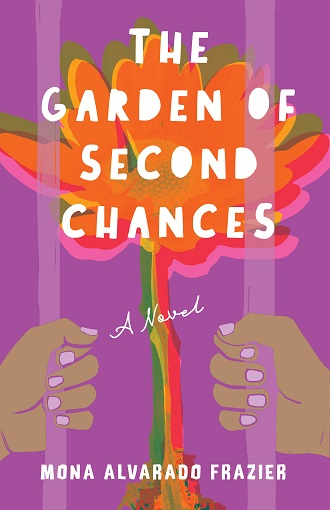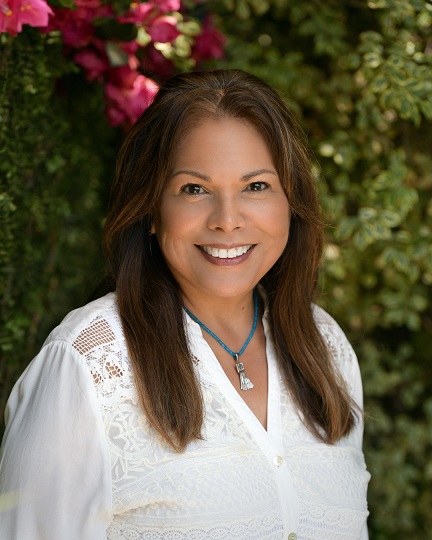Throughout my career, I’ve met countless young women who experienced intimate partner violence (IPV) and were often blamed for their victimization or pressured into committing crimes with their partners. Their stories inspired me to share their experiences.
Mona Alvarado Frazier – 23 June 2023
The Back Flap
Juana’s life has taken a dark turn. Accused of her husband’s death, she’s now a seventeen-year-old mother, alone and undocumented in a prison cell. No one believes her when she claims she’s innocent, not even the prison staff or the gang leader in her block who torments her relentlessly.
Her only solace is in her baby, but as Juana struggles to survive the dangers lurking in prison, the threat outside grows even more terrifying. Her husband’s furious family wants to take the child away.
With no hope in sight, Juana discovers a glimmer of light in a small patch of earth in the prison yard. As she nurtures the plants, memories of her mother’s strength and resilience surface, pushing Juana to fight for her freedom and her daughter’s future. This is a story of courage, hope, and determination in the face of impossible odds.
About the book
What is the book about?
Juana Ivanov is a young Mexican immigrant whose life takes an unexpected turn when she finds herself trapped in a California prison. Her biggest fear is her daughter’s safety, who is far away in Mexico and under the care of her sister, who is desperate to immigrate to the US.
Struggling to adapt to the harsh realities of prison life, Juana discovers a glimmer of hope amidst the bleakness as she tends to a garden she created. It is here that she unearths the inner strength and determination that she inherited from her late mother.
With her daughter’s safety always on her mind, Juana sets out to clear her name and reunite with her little girl. But the road ahead is fraught with danger and obstacles. Juana must navigate the complexities of the Criminal Justice system, confront her past, and find allies in unexpected places to help her achieve her goal.
This young adult novel is a tale of strength, courage, and a mother’s unwavering love for her child.
When did you start writing the book?
I began writing the novel in 2010.
How long did it take you to write it?
The book took a year to draft and several years to revise. During that time, I submitted the first chapter to Amazon’s Breakout Book, and it made the quarter-finals in 2013. I received a writing fellowship from that first chapter to A Room of Her Own (AROHO) writer’s residency. The Association of Writers Program (AWP) selected me for their 2014 mentorship program, and my mentor, Fred Arroyo, helped me revise the manuscript again.
After approximately 50 queries, I put it aside and began writing another novel. After writing two more books, I returned to Juana’s story in 2020. I revised it again and had a publishing contract in 2021. So, it took about ten years to write and revise.
Where did you get the idea from?
Throughout my career, I’ve met countless young women who experienced intimate partner violence (IPV) and were often blamed for their victimization or pressured into committing crimes with their partners. Their stories inspired me to share their experiences.
It is important to note that the story I wrote is not based on one specific girl or crime but is a blend of numerous stories of young women who have experienced violence, addiction, neglect, and incarceration.
Writing about IPV or domestic violence is never easy, as many of us fear judgment or shame. But every time we share out story, we give people an opportunity to understand. What these young women need is compassion, not judgment. Writing about IPV or retelling your story of IPV does not diminish you; it empowers you.
I wrote this book to highlight the value of incarcerated women and help people understand the obstacles they face inside and outside prison. It’s challenging for anyone to prove their innocence. Still, it’s especially difficult for young women who have immigrated, experienced violence, and may not be proficient in the language of their community. These young women are often marginalized, and their stories are overlooked. But by sharing this novel, I hope to give them a voice and shed light on their issues.
I hope the novel will inspire others to advocate for change and support women on their journey toward healing. Top of FormBottom of FormBottom of Form
Were there any parts of the book where you struggled?
The most difficult part was the physical abuse because I relived some of the violence I had experienced. Putting the anger, humiliation, fear, and loss of self-esteem into words was challenging. The other areas that proved demanding were the scenes where the main character is in the isolation room (segregation) and losing hope and the will to live.
What came easily?
The layout of the prison buildings and daily routines was the easiest part.
Are your characters entirely fictitious, or have you borrowed from real-world people you know?
The story is not based on one girl or one specific crime but is a blend of numerous stories about young adults who experienced violence, addictions, neglect, and incarceration. Everyone in the novel is fictional.
We all know how important it is for writers to read. Are there any particular authors that have influenced how you write, and if so, how have they influenced you?
I enjoy reading several genres and read women writers primarily. I love Barbara Kingsolver’s poetic style, Aida Salazar’s and Angie Thomas’s social justice themes in MG and YA books, and Kristin Valdez Quade for her empathetic portrayal of “damaged souls.” I aspire to write as well as they do, but it’s an extremely high bar.
Do you have a target reader?
My readers would be those interested in social justice, the juvenile justice system, immigration, intimate partner violence, teen mothers, and multicultural characters.
About Writing
Do you have a writing process? If so, can you please describe it?
I have a morning writing ritual that begins between 6:30 and 8:00 a.m. Before I sit at my computer to write, I pour myself a cup of coffee, light a candle, and have my vial of essence oils handy. Sometimes it’s lavender oil, and sometimes peppermint.
I like complete silence, so no music plays, and the door to the bedroom is shut. Which often magically summons my two grand kitties to the room, where they meow until I open the door. I usually write for 45-60 minutes and take a ten-minute break to pour another cup of coffee. I’ll write for another 45-60 minutes and then have breakfast. I don’t answer my phone or messages unless it’s my mother or kids. When I’m revising, I’m at the computer for several hours until I’m exhausted.
Do you outline? If so, do you do so extensively or just chapter headings and a couple of sentences?
I’m a panster who aspires to be a plotter. The furthest I go is writing a premise, and a few paragraphs of what I think will happen. I write sketches for the characters I know will be in the novel. I’ve used the profiles in One Stop for Writers blog before and print them out. Every story has a manila folder where I throw ideas on scraps of paper. Mostly, I keep the story in my head. When I have the first draft, I write a few sentences about what happens in each scene. So, I outline after the first draft.
Do you edit as you go or wait until you’ve finished?
I cannot lie; I edit as I go, which I’ve tried to stop doing, especially in a first draft.
Did you hire a professional editor?
I’ve been lucky to have a couple of mentors through different writing organizations that helped me in this novel’s early stages of revision. I hired professional editors for the first five chapters and after several novel revisions for two other manuscripts. Reedsy.com is an excellent place to seek out editors. I’ve also bid for editorial services when We Need Diverse Books has its fundraisers.
Do you listen to music while you write? If yes, what gets the fingers tapping?
No, it’s distracting to me. However, in my next novel, I did have a playlist of early 1970s music that I needed to listen to before I wrote some of the scenes.
About Publishing
Did you submit your work to Agents?
I’d say approximately 75 lit agents throughout the years for this novel.
What made you decide to go Indie, whether self-publishing or with an indie publisher? Was it a particular event or a gradual process?
I like to enter writing contests, and a friend told me about the STEP publishing contest with She Writes Press. I entered and won.
Did you get your book cover professionally done, or did you do it yourself?
Getting a professional book cover is worth the money unless you are excellent at graphic design. The cover is professionally done by Rebecca Lown Design. The publisher contracts with the designer.
Do you have a marketing plan for the book, or are you just winging it?
I’ve spent the last three years educating myself on marketing for authors. I subscribed to several blogs, watched numerous YouTube videos on marketing, and read a few books on marketing your book. I don’t believe an author should wing it.
There’s a lot of free advice from great marketers, and you can borrow or buy books cheaply. I drafted a marketing timeline for myself. Start early and be consistent.
Any advice that you would like to give to other newbies considering becoming Indie authors?
Educate yourself on the craft of writing in your genre. Read in your genre. When you decide to write, give yourself a time limit of 15 minutes or 1 hour a day for x number of days, and be consistent.
Participate in the book world by following people on social media and having conversations. Become a member of at least one writer’s organization. Write first, use social media after your goal for the day, and don’t spread yourself thin. You don’t have to be on all social media sites. You don’t have to have thousands of followers. Be genuine when interacting.
About You
Where did you grow up?
Oxnard, California, on the coast between Los Angeles and Santa Barbara.
Where do you live now?
Oxnard, California.
What would you like readers to know about you?
I love travel planning. Part of the fun is to read a book set in the location, research travel sites, and learn a few words in the language where I’m going. I enjoy learning about other cultures, languages, and foods. Travel is a catalyst for gaining a wider understanding of other people.
What are you working on now?
A Bridge Home takes place during a tumultuous time in American history. Against the backdrop of the Vietnam War and the societal changes in 1972, seventeen-year-old Jacqui Bravo struggles to fulfill her dreams after her father’s death.
The novel will debut in December 2024.
End of Interview:
For more from Mona Alvarado Frazier, visit her website and follow her on Twitter and Instagram.
Get your copy of The Garden of Second Chances from Amazon US or Amazon UK.


